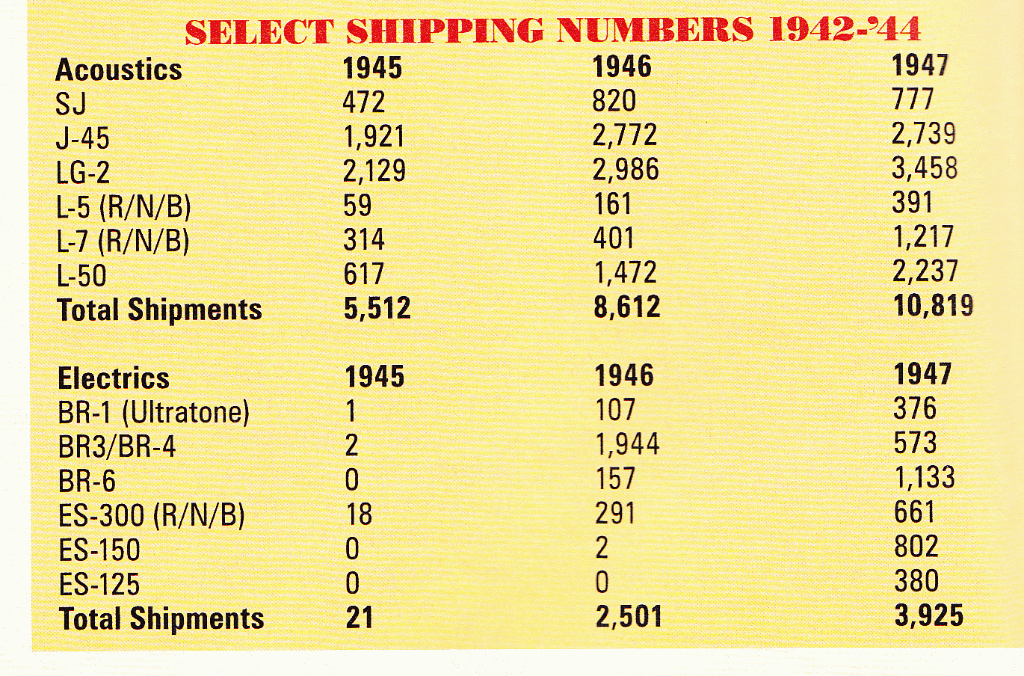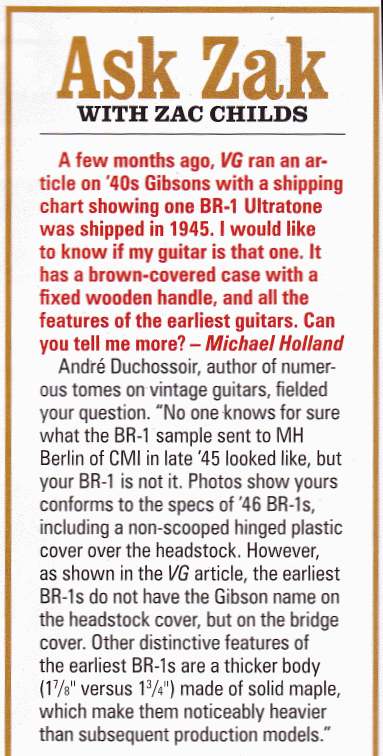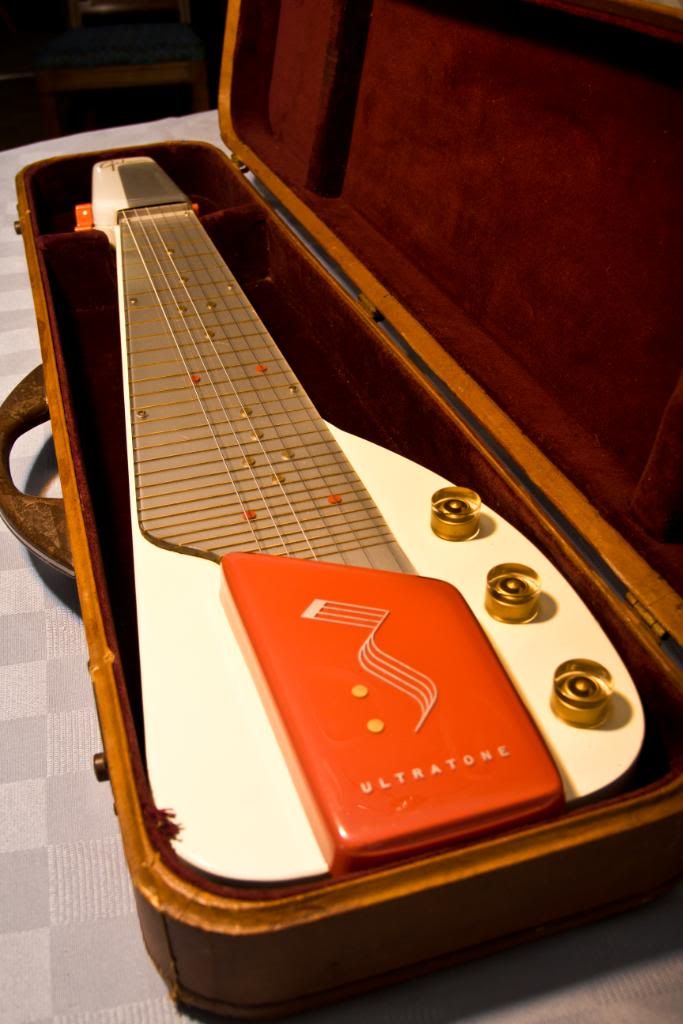| Author |
Topic: 1946 Gibson Ultratone in near mint condition |
Michael Holland
From:
Nashville, Tennessee, USA
|
 Posted 7 Feb 2013 8:22 pm
Posted 7 Feb 2013 8:22 pm |
|
Vintage Guitar Magazine ran an article a couple months ago featuring Gibson lap steels. Gibson shipping records show that one BR-1 was shipped in 1945, the first year of production. Is it possible that my Ultratone is that guitar? My guitar's case features a fixed wooden handle with a cosmetic metal insert. Did later production cases have hinged handles? There is no serial number anywhere on my guitar. I know that potentiometers can be dated, but that in itself is not dispositive. I'm going to take the guitar to George Gruhn for authentication, but I wanted to get the knowledgeable opinions of my SGF Bros first. Here's the link to the Photobucket album.
http://s1112.photobucket.com/albums/k499/GuitarofNashville/1940s%20Gibson%20Ultratone/

Last edited by Michael Holland on 17 May 2013 7:48 pm; edited 1 time in total |
|
|
 |
Peter Huggins
From:
Van Nuys, California, USA
|
 Posted 8 Feb 2013 12:12 am
Posted 8 Feb 2013 12:12 am |
|
Gibson did not put serial numbers on any of their Lap Steels after the war up until 1952-3, when they started using inked numbers on both the steels and the Les Paul Models. The steels were the only other solid body guitars built by Gibson at the time (actually very few postwar Gibsons had serial numbers up until 1950 or later). Therefore, none of the first generation Ultratones had a serial number.
Hard to tell if your Ultratone is the first one or not, but if the pot codes date to 1945 then it is a serious contender. In any event the wooden handle on the case, if it is original, would also be a very early indicator.
At the Guitarlington show in Texas the last two years, there was a Barnes & Reinecke prototype BR-1. It looked much like the production model (down to the Ultratone name on the hinged pickup cover and 'Chiclet' tuner buttons) except that the hinged tuning cover did not say Gibson, and the finish was a gold metalflake, much like Dick Dale's Stratocaster. The info card stated that Gibson told B&R that the model would be far too expensive to put into production; however the model as released was identical except for the white finish and the Gibson name on the tuner cover. I have a photo somewhere and will try to locate it and post it.
_________________
A big THANKS to all my friends, here and everywhere ! |
|
|
 |
Peter Huggins
From:
Van Nuys, California, USA
|
 Posted 8 Feb 2013 12:22 am
Posted 8 Feb 2013 12:22 am |
|


_________________
A big THANKS to all my friends, here and everywhere ! |
|
|
 |
Jim Pitman
From:
Waterbury Ctr. VT 05677 USA
|
 Posted 8 Feb 2013 10:27 am
Posted 8 Feb 2013 10:27 am |
|
That lap steel has such a great vibe.
I'd call it "art deco boat paddle"
Plastic was a relatively new invention back then and it looks like Gibson really embraced it. Those are some wonderful translucent appointments, right down to the knobs.
I have a Catalin plastic Emerson radio made form Uriah formaldahyde plastic (yep-piss). It's all translucent swirly green. It is historically significant because it was one of the first consumer products to be made out of molded plastic. Love that era. |
|
|
 |
Michael Holland
From:
Nashville, Tennessee, USA
|
 Posted 8 Feb 2013 8:01 pm
Posted 8 Feb 2013 8:01 pm |
|
| Yeah, Jim, the quality of the early plastic is amazing. One thing I forgot to mention about my guitar is that the rear cavity plate is clearly made of bakelite. And thanks for your contribution, Peter. That's very good information that I've never seen before. |
|
|
 |
Steve Ahola
From:
Concord, California
|
 Posted 9 Feb 2013 12:44 am
Posted 9 Feb 2013 12:44 am |
|
| Michael Holland wrote: |
| One thing I forgot to mention about my guitar is that the rear cavity plate is clearly made of bakelite. |
My '49 Century 6 (country bumpkin cousin of the Ultratone) has a bakelite control cavity plate, too. The date codes on the pots should help narrow down the date of your Ultratone (I think it would be obvious if they have been replaced.) BTW is your control compartment shielded with the foil-lined cardboard?
Steve Ahola
_________________
www.blueguitar.org
Recordings on electric guitar:
http://www.box.net/blue-diamonds
http://www.box.net/the-culprits |
|
|
 |
Michael Holland
From:
Nashville, Tennessee, USA
|
 Posted 17 May 2013 7:29 pm Got my answer!
Posted 17 May 2013 7:29 pm Got my answer! |
|
Decided to ask Zac Childs, who publishes a monthly column in Vintage Guitar magazine. He was kind enough to pass on my question to George Gruhn, who forwarded it on to Andre Duchossoir. The question was published in the new VG that I received yesterday. And mine is one of the 107 shipped in 1946!


_________________
"I am certain of nothing", Anthony Bourdain |
|
|
 |
Tom Pettingill
From:
California, USA (deceased)
|
|
|
 |




